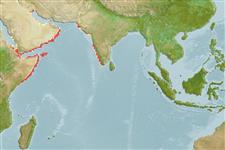>
Eupercaria/misc (Various families in series Eupercaria) >
Haemulidae (Grunts) > Haemulinae
Etymology: Pomadasys: Greek, poma, -atos = cover, operculum + Greek, dasys = with hair (Ref. 45335).
More on author: Rüppell.
Environment: milieu / climate zone / depth range / distribution range
Ökologie
seewasser demersal; tiefenbereich ? - 50 m (Ref. 97537). Tropical
Western Indian Ocean: Red Sea to the Gulf of Oman.
Size / Gewicht / Alter
Maturity: Lm ? range ? - ? cm
Max length : 30.0 cm TL Männchen/unbestimmt; (Ref. 11441)
Rückenflossenstacheln (insgesamt): 12; Rückenflossenweichstrahlen (insgesamt): 15; Afterflossenstacheln 3; Afterflossenweichstrahlen: 8. Caudal fin slightly forked; silvery in color, the back with a yellow-green iridescence, with a slightly irregular, longitudinal dark brown lines on about three-fourths of body; fins dusky, the caudal darkest; a diffuse blackish blotch on membranes anteriorly in middle of pelvic fins; palate and part of sides of mouth dull orange-red (Ref. 11441).
Occurs inshore on rocky bottoms (Ref. 11441). Stomach contents of specimens collected from Iraq composed mainly of mollusks, sponges and tunicates (Ref. 97537).
Life cycle and mating behavior
Geschlechtsreife | Fortpflanzung | Ablaichen | Eier | Fecundity | Larven
Oviparous, distinct pairing during breeding (Ref. 205).
Randall, J.E., 1995. Coastal fishes of Oman. University of Hawaii Press, Honolulu, Hawaii. 439 p. (Ref. 11441)
IUCN Rote Liste Status (Ref. 130435)
Bedrohung für Menschen
Harmless
Nutzung durch Menschen
Mehr Information
ReferenzenAquakulturAquakultur ProfilZuchtlinienGenetikElectrophoresesVererbbarkeitKrankheitenVerarbeitungNutrientsMass conversion
PartnerBilderStamps, Coins Misc.LauteCiguateraGeschwindigkeitSchwimmstilKiemenoberflächeOtolithsGehirngrößeSehfähigkeit
Tools
Zusatzinformationen
Download XML
Internet Quellen
Estimates based on models
Preferred temperature (Ref.
123201): 25.2 - 29.3, mean 27.5 °C (based on 164 cells).
Phylogenetic diversity index (Ref.
82804): PD
50 = 0.5000 [Uniqueness, from 0.5 = low to 2.0 = high].
Bayesian length-weight: a=0.01445 (0.00668 - 0.03127), b=2.99 (2.82 - 3.16), in cm total length, based on LWR estimates for this Genus-body shape (Ref.
93245).
Trophic level (Ref.
69278): 3.4 ±0.4 se; based on size and trophs of closest relatives
Widerstandsfähigkeit (Ref.
120179): mittel, Verdopplung der Population dauert 1,4 - 4,4 Jahre. (Preliminary K or Fecundity.).
Fishing Vulnerability (Ref.
59153): Low vulnerability (20 of 100).
